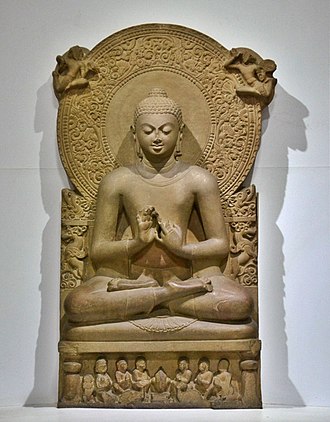Gautama Buddha[note 4] (also Siddhārtha Gautama, Siddhattha Gotama;[note 5] Shakyamuni, Sakkamuni;[note 6] and The Buddha[note 7]) was an ascetic and spiritual teacher of ancient India who lived during the 6th or 5th century BCE.[4][5][6][note 8] He was the founder of Buddhism and is revered by Buddhists as a fully enlightened being[7][8][note 9] who taught a path to Nirvana (lit. vanishing or extinguishing), freedom from ignorance, craving, rebirth and suffering.
According to Buddhist tradition, the Buddha was born in Lumbini in what is now Nepal,[note 2] to highborn parents of the Shakya clan, but abandoned his family to live as a wandering ascetic.[9][note 10] Leading a life of begging, asceticism, and meditation, he attained enlightenment at Bodh Gaya. The Buddha thereafter wandered through the lower Gangetic plain, teaching and building a monastic order. He taught a middle way between sensual indulgence and severe asceticism,[10] a training of the mind that included ethical training and meditative practices such as effort, mindfulness, and jhana. He died in Kushinagar, attaining paranirvana.[note 3] The Buddha has since been venerated by numerous religions and communities across Asia.
Several centuries after the Buddha’s death, his teachings were compiled by the Buddhist community in the Vinaya, his codes for monastic practice, and the Suttas, texts based on his discourses. These were passed down in Middle Indo-Aryan dialects through an oral tradition.[11][12] Later generations composed additional texts, such as systematic treatises known as Abhidharma, biographies of the Buddha, collections of stories about his past lives known as Jataka tales, and additional discourses, i.e. the Mahayana sutras.[13][14]






